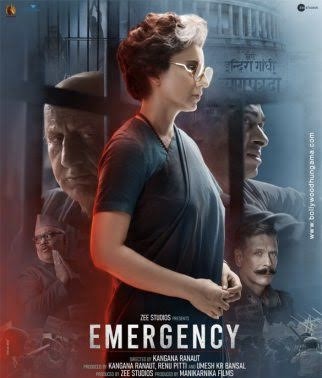Read our detailed review of Kangana Ranaut’s political drama Emergency (2024), based on the life of Indira Gandhi and the events of 1975. Discover the performances, story impact, and how well the film balances history and drama.

Directed by: Kangana Ranaut
Starring: Kangana Ranaut, Anupam Kher, Shreyas Talpade, Mahima Chaudhry, Satish Kaushik
Genre: Political Drama | Historical Biopic
Language: Hindi
Runtime: 2 hours 25 minutes
Best Movie Review Rating: ★★★☆☆ (3/5)
Introduction
In Indian history, few events have had such a profound and controversial impact as the Emergency period from 1975 to 1977, declared by then Prime Minister Indira Gandhi. The movie Emergency, directed by Kangana Ranaut, attempts to bring this intense chapter of Indian democracy to the silver screen, with all its political turbulence, moral dilemmas, and power struggles.
While the film succeeds in presenting a bold portrayal of one of the most debated leaders in Indian history, it occasionally stumbles under the weight of its ambition, struggling to balance fact, drama, and artistic liberty.
Plot Summary (Spoiler-Free)
Emergency opens in June 1975, as political tensions rise across India. Amidst growing opposition, protests, and judicial scrutiny, Prime Minister Indira Gandhi (Kangana Ranaut) makes the fateful decision to declare a state of Emergency — effectively suspending civil liberties, arresting opposition leaders, and consolidating power.
The narrative spans across her inner political circle, opposition leaders like Jayaprakash Narayan (Anupam Kher), her controversial relationship with Sanjay Gandhi, and the consequences of her actions on the Indian populace. The film navigates through courtroom judgments, internal Congress party debates, and voices of dissent from both inside and outside the system.
Instead of painting Gandhi as a one-dimensional figure, the movie attempts to explore her complexities — as a leader, a mother, and a woman in a man’s world.
Performances
Kangana Ranaut as Indira Gandhi
Kangana delivers a powerful yet stylized performance. She nails the body language and speech patterns of Indira Gandhi, and her screen presence carries much of the film’s weight. However, in some moments, her portrayal leans more toward imitation than emotional immersion. While she clearly invested in researching the role, the performance occasionally lacks subtlety, especially during emotionally intense scenes.
Anupam Kher as Jayaprakash Narayan
Kher brings quiet dignity to his role as the Gandhian socialist leader who leads the resistance. His performance stands out, providing moral contrast to Indira Gandhi’s authoritarian shift. His calm yet firm delivery gives weight to every scene he’s in.
Shreyas Talpade as Atal Bihari Vajpayee
Though his role is small, Talpade’s portrayal of a young Atal Bihari Vajpayee is respectful and understated. He doesn’t mimic Vajpayee’s famous oratory style heavily, but rather hints at the emerging leader’s diplomatic strength.
Mahima Chaudhry and Satish Kaushik
Mahima Chaudhry plays Pupul Jayakar, a close confidante of Gandhi, offering a lens into her emotional and personal conflicts. Satish Kaushik delivers one of his final performances as a senior Congress leader, reminding us of his incredible range.
Direction and Screenplay
Kangana Ranaut, as director, deserves credit for choosing such a bold and politically sensitive subject. She doesn’t shy away from showing the dark side of Emergency — censorship, forced sterilizations, arrests of journalists and activists, and the misuse of constitutional powers. The screenplay attempts to juggle historical detail with cinematic storytelling.
However, the execution sometimes feels inconsistent. The pacing drags in the first half, bogged down by exposition. The second half picks up with emotional confrontations and courtroom drama, but occasionally becomes theatrical. Some dialogues feel scripted rather than natural, which reduces the realism of intense scenes.
Cinematography and Production Design
The film’s production design is impressive. From recreated parliament halls to Indira Gandhi’s office and press rooms, the settings are rich in period detail. The use of dim lighting and shadows reflects the political gloom of the era.
Cinematographer Tetsuo Nagata brings a stylized yet controlled visual tone to the film. However, some scenes — especially crowd protests — seem underpopulated and lack the large-scale intensity the situation demands.
Music and Background Score
GV Prakash Kumar’s background score is appropriately somber and serious, though not particularly memorable. The film doesn’t rely much on songs, which suits its tone. A couple of situational tracks are woven in as montages but don’t leave a lasting impression.
Historical Accuracy vs. Dramatization
The film attempts to stay relatively close to real events, referencing actual quotes, Supreme Court judgments, and political speeches. However, it also takes creative liberties, particularly in character interactions and dramatized dialogues.
Critics may argue that the portrayal of Indira Gandhi is not entirely balanced — sometimes sympathetic, sometimes demonized. The film avoids labeling her a dictator outright, instead presenting her as a conflicted leader who believed her decisions were necessary. This approach may leave both supporters and critics of Gandhi divided.
Themes
- Power and accountability
- Democracy vs. authoritarianism
- The role of media and opposition
- Personal vs. political responsibility
These themes are timeless and relevant, especially in the context of rising global political polarizations. Emergency reminds viewers of how fragile democracy can be if unchecked.
What Works
- Bold subject matter
- Strong lead performance
- Well-designed sets and period costumes
- Historical relevance and thought-provoking moments
- Solid supporting cast
What Doesn’t Work
- Uneven pacing
- Over-dramatization in some scenes
- Some dialogues lack emotional depth
- Could have used more nuanced storytelling
Final Verdict
Emergency is a brave cinematic attempt to depict one of the most turbulent political chapters in India’s democracy. Kangana Ranaut, both as actor and director, deserves applause for taking the risk — even if the execution is not flawless.
The film educates, provokes, and opens up a discussion on leadership, power, and the cost of political control. For students of Indian politics, history buffs, or even younger generations unfamiliar with the 1975 Emergency, this film is an eye-opener.
Best Movie Review Rating: 3/5
Verdict: A bold, thought-provoking political drama that tells an important story — even if it fumbles in places.